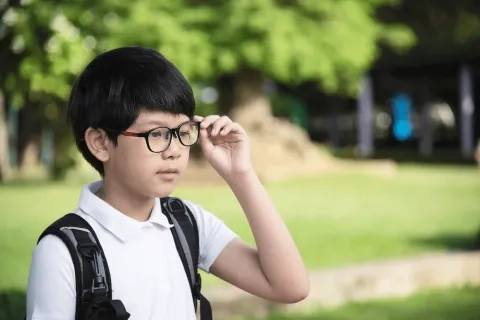The Importance of Myopia Management
Understanding the importance of myopia management

Why is myopia a concern?
Myopia, more commonly known as short-sightedness, is now a global public health concern. In particular, the increasing prevalence of myopia in young children has since become an urgent issue to tackle among eye care professionals globally.
The World Health Organisation (WHO) has recognized myopia as a public health issue and released a joint report with the Brien Holden Vision Institute in 20161. It is predicted that nearly 5 billion of the world’s population will have myopia by 2050 and almost 1 billion will progress into high myopia. In fact, it is estimated that close to 50% of the population in Singapore will develop high myopia as well2.
Raising public awareness about myopia

The predictions on the Singapore population is particularly worrying as this translates to a significant number of high myopes (-5.00D and above) having an increased risk of related vision threatening conditions such as retinal detachment, myopic macular degeneration and glaucoma3, which eventually can lead to blindness.
Many parents see the onset of myopia as unavoidable and that it is a ‘normal process’ for children to develop myopia. It is inevitable that parents adopt such a mentality due to the lack of reports on myopia management, with the accompanying fact that there is a noticeable large number of young children that begin to wear spectacles even before they attend primary schools. The lack of a compelling need to intervene in myopia development can create risks in time to come as myopia is no longer just a simple refractive error.
When a child develops myopia at 7 years old, the probability of the child progressing to high myopia is three times higher5,6 as compared to a child who has a myopia onset at 12 years old.

Studies have shown that one contributing factor to the development of myopia is having a family history with parental myopia. However, having reduced outdoor time with high amount of time spent on near work poses an even higher threat.7,8 This emphasizes on the importance of education and awareness for all parents that preventing or delaying myopia onset is possible.
Hence, WHO’s recognition to address the rapidly increasing prevalence and the impact of myopia on the visual, social and economic environment; was a historic step in placing myopia on the world health agenda9.
What is myopia management?

Myopia management means identifying the risk factors for myopia onset (even before a child develops myopia), prescribing corrections when needed and providing information and advice to both parent and child.
There are ongoing studies with several promising approaches to control myopia onset and progression10. These studies provide optimism that it is possible to reduce the number of people progressing to high myopia and thus, mitigating the risks associated with this condition. However, substantial support from the government and healthcare system is essential in order to generate enough public awareness to effectuate the motion.
Myopia management will require constant reviewing of measures and years of commitment. There is no one-size-fits-all solution but we need to weigh the risks involved if no intervention is being done at all.
Let us all fight the battle of myopia together!
References:
- The Impact of Myopia and high Myopia. Report of the Joint World Health Organization-Brien Holden Vision Institute Global Scientific Meeting on Myopia. University of New South Wales, Sydney, Australia 16-18 March 2015.
- Holden BA, Jong M, Davis S et al. Nearly 1 billion myopes at risk of myopia-related sight-threatening conditions by 2050 - time to act now. Clin Exp Optom. 2015;98:491-3.
- Flitcroft D.I, The complex interactions of retinal, optical and environmental factors in myopia aetiology. Progress in Retinal and Eye Research 31 (2012) 622-660
- Mutti DO, Mitchell GL, Moeschberger ML, Jones LA, Zadnik K. Parental myopia, near work, school achievement, and children's refractive error. Invest Ophthalmol Vis Sci. 2002;43(12):3633‐3640.
- Chua SY, Sabanayagam C, Cheung YB, et al. Age of onset of myopia predicts risk of high myopia in later childhood in myopic Singapore children. Ophthalmic Physiol Opt. 2016;36(4):388‐394.
- Sankaridurg P. A less myopic future: what are the prospects?. Clin Exp Optom. 2015;98(6):494‐496.
- Cao K, Wan Y, Yusufu M, Wang N. Significance of Outdoor Time for Myopia Prevention: A Systematic Review and Meta-Analysis Based on Randomized Controlled Trials. Ophthalmic Res. 2020;63(2):97‐105.
- Huang HM, Chang DS, Wu PC. The Association between Near Work Activities and Myopia in Children-A Systematic Review and Meta-Analysis. PLoS One. 2015;10(10):e0140419. Published 2015 Oct 20.
- Holden BA, Jong M, Davis S, Wilson D, Fricke T, Resnikoff S. Nearly 1 billion myopes at risk of myopia-related sight-threatening conditions by 2050 - time to act now. Clin Exp Optom. 2015;98(6):491‐493.
- Wu PC, Huang HM, Yu HJ, Fang PC, Chen CT. Epidemiology of Myopia. Asia Pac J Ophthalmol (Phila). 2016;5(6):386‐393.
- Blindness and visual impairment. World Health Organization website.
- Assessing Risk of Myopia Onset and Progression. Myopia Profile website.
Recent Blog Posts
- 19 Oct 2022
- 19 Oct 2022
- 19 Oct 2022
- 19 Oct 2022
- 19 Oct 2022
